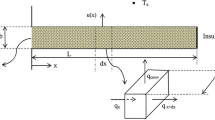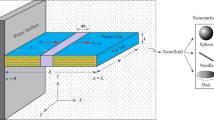Abstract
The extended surfaces, known as fins, are of great importance in various industrial applications in electric/electronic devices, heat exchangers, power plants, etc. Recently, it is demonstrated that porous fins, as a potential candidate for traditional fins, may significantly enhance the thermal performance of such equipment. To this end, in the current research work, based upon the Maxwell equations, Rosseland diffusion approximation and Darcy formulation, the impacts of magnetic field, radiation heat transfer and porous medium are incorporated in the problem formulation which is inherently a nonlinear differential equation. It is well-known that particle base methods are accurate enough in dealing with thermal analysis of mechanical structures, however, calculation of interactions between atoms as well as discretization of space and time in these approaches is a time-consuming task leading to high computational costs when the dimension of the structure is sizeable. In order to study such problems, other efficient numerical/asymptotic approaches are preferred. However, it may be also considered as a new introduced approach of particle base methods. In this paper, the Sinc collocation method (SCM) is successfully employed to study the distribution of temperature as well as temperature gradient in porous fin subject to a uniform magnetic field. SCM discretizes the nonlinear boundary value problem to a system of nonlinear equations. The obtained numerical solutions are compared with other existing methods in the literature. The results can support the capability and accuracy of the proposed method.












Similar content being viewed by others
References
Hoseinzadeh S, Moafi A, Shirkhani A, Chamkha AJ. Numerical validation heat transfer of rectangular cross-section porous fins. J Thermophys Heat Transf. 2019;33(3):698–704.
Hoseinzadeh S, Heyns PS, Chamkha AJ, et al. Thermal analysis of porous fins enclosure with the comparison of analytical and numerical methods. J Therm Anal Calorim. 2019;138:727–35.
Chamkha AJ. Hydromagnetic natural convection from an isothermal inclined surface adjacent to a thermally stratified porous medium. Int J Eng Sci. 1997;35(10–11):975–86.
Mehryan SAM, Izadpanahi E, Ghalambaz M, et al. Mixed convection flow caused by an oscillating cylinder in a square cavity filled with Cu–Al2O3/water hybrid nanofluid. J Therm Anal Calorim. 2019;137:965–82.
Alsabery AI, Mohebbi R, Chamkha AJ, Hashim I. Effect of local thermal non-equilibrium model on natural convection in a nanofluid-filled wavy-walled porous cavity containing inner solid cylinder. Chem Eng Sci. 2019;201:247–63.
Kumar KG, Rahimi-Gorji M, Reddy MG, et al. Enhancement of heat transfer in a convergent/divergent channel by using carbon nanotubes in the presence of a Darcy-Forchheimer medium. Microsyst Technol. 2020;26:323–32.
Mesgarpour M, Heydari A, Saddodin S. Investigating the effect of connection type of a sintered porous fin through a channel on heat transfer and fluid flow. J Therm Anal Calorim. 2019;135:461–74.
Neyestani M, Nazari M, Shahmardan MM, et al. Thermal characteristics of CPU cooling by using a novel porous heat sink and nanofluids. J Therm Anal Calorim. 2019;138:805–17.
Ndlovu P. Numerical analysis of transient heat transfer in radial porous moving fin with temperature dependent thermal properties. J Appl Comput Mech. 2020;6(1):137–44.
Babu D, Venkateswarlu S, Keshava Reddy E. Multivariate Jeffrey fluid flow past a vertical plate through porous medium. J Appl Comput Mech. 2020;6(3):605–16.
Yadav D. The density-driven nanofluid convection in an anisotropic porous medium layer with rotation and variable gravity field: a numerical investigation. J Appl Comput Mech. 2020;6(3):699–712.
Rahmani M, Mohammadi Y, Kakavand F, Raeisifard H. Vibration analysis of different types of porous FG conical sandwich shells in various thermal surroundings. J Appl Comput Mech. 2020;6(3):416–32.
Takhar HS, Chamkha AJ, Nath G. Unsteady three-dimensional MHD-boundary-layer flow due to the impulsive motion of a stretching surface. Acta Mech. 2001;146:59–71.
Dogonchi AS, Armaghani T, Chamkha AJ, et al. Natural convection analysis in a cavity with an inclined elliptical heater subject to shape factor of nanoparticles and magnetic field. Arab J Sci Eng. 2019;44:7919–31.
Dogonchi AS, Tayebi T, Chamkha AJ, et al. Natural convection analysis in a square enclosure with a wavy circular heater under magnetic field and nanoparticles. J Therm Anal Calorim. 2020;139:661–71.
Chamkha AJ, Ismael M, Kasaeipoor A, Armaghani T. Entropy generation and natural convection of CuO-water nanofluid in C-Shaped cavity under magnetic field. Entropy. 2016;18:50.
Chamkha AJ, Takhar HS, Nat G. Mixed convection flow over a vertical plate with localized heating (cooling), magnetic field and suction (injection). Heat Mass Transf. 2004;40:835–41.
Aldoss TK, Ali YD, Al-Nimr MA. MHD mixed convection from a horizontal circular cylinder. Numer Heat Transf. 1996;30(4):379–96.
Shehzad A, Ali R. Approximate analysis solution for magneto-hydrodynamic flow of a non-newtonian fluid over a vertical stretching sheet. Can J Appl Sci. 2012;2(1):202.
Aziz T, Mahomed FM, Shahzad A, Ali R. Travelling wave solutions for the unsteady flow of a third grade fluid induced due to impulsive motion of flat porous plate embedded in a porous medium. J Mech. 2014;30(5):527–35.
Nayfeh AH. Perturbation methods. New York: Wiley; 2000.
He JH. A coupling method of homotopy technique and perturbation technique for nonlinear problems. Int J Non-Linear Mech. 2000;35(1):37–43.
He JH. Homotopy perturbation method for bifurcation of nonlinear problems. Int J Nonlinear Sci Numer Simul. 2005;6:207–8.
Ganji DD. The application of He’s homotopy perturbation method to nonlinear equations arising in heat transfer. Phys Lett A. 2006;355:337–41.
Esmaeilpour M, Ganji DD, Mohseni E. Application of homotopy perturbation method to micropolar flow in a porous channel. J Porous Media. 2009;12(5):451–9.
Torabi M, Yaghobi H, Saedin S. Assessment of Homotopy Perturbation Method in nonlinear convective-radiative nonfourier conduction heat transfer equation with variable coefficient. Therm Sci. 2011;15(2):S263–74.
Singh JK, Gupta K, Nath P, Kabindra RAI. Variation Iteration Method to solve moving boundary problem with temperature dependent physical properties. Therm Sci. 2011;15(2):229–39.
Momani S, Abuasad S. Application of He’s variational iteration method to Helmholtz equation. Chaos Solitons Fractals. 2006;27(5):1119–23.
Ganji DD, Jamshidi N, Ganji ZZ. HPM and VIM methods for finding the exact solutions of the nonlinear dispersive equations and seventh-order Sawada–Kotera equation. Int J Mod Phys B. 2009;23(1):39–52.
Ganji DD, Mohseni Languri E. Mathematical Methods in Nonlinear Heat Transfer. Bloomington: Xlibris Corporation; 2010.
Liao SJ. On the homotopy analysis method for nonlinear problems. Appl Math Comput. 2004;47(2):499–513.
Hatami M, Hasanpour A, Ganji DD. Heat transfer study through porous fins (Si3N4 and AL) with temperature-dependent heat generation. Energy Convers Manag. 2013;74:9–16.
Aziz A, Bouaziz MN. A least squares method for a longitudinal fin with temperature dependent internal heat generation and thermal conductivity. Energy Convers Manag. 2011;52:2876–82.
Hoshyar HA, Ganji DD, Majidian AR. Least square method for porous fin in the presence of uniform magnetic field. J Appl Fluid Mech. 2016;9(2):661–8.
Stenger F. Numerical methods based on Sinc and analytic functions. New York: Springer; 1993.
Tanaka K, Sugihara M, Murata K. Function clasess for successful DE-Sinc approximations. Math Comput. 2009;78:1553–71.
Lund J, Bowers K. Sinc methods for quadrature and differential equation. Philadelphia: SIAM; 1992.
Nabati M, Jalalvand M. Solution of Troesch’s problem through double exponential Sinc-Galerkin method. Comput Methods Differ Equ. 2017;5(2):141–57.
Rashidini J, Nabati M, Barati A. Sinc-Galerkin method for solving nonlinear weakly singular two point boundary value problems. Int J Comput Math. 2017;94(1):79–94.
Rashidinia J, Nabati M, Parsa A. Solving a class of nonlinear boundary value problems with Sinc-Collocation method based on double exponential transformation. UPB Sci Bull Ser A. 2014;76(4):1–10.
Taklifi A, Aghanajafi C, Akrami H. The effect of MHD on a porous fin attached to a vertical isothermal surface. Transp Porous Med. 2010;85:215–31.
Khani F, Ahmadzadeh-Rajib M, Hamedi-Nejad H. Analytical solutions and efficiency of the nonlinear fin problem with temperature-dependent thermal conductivity and heat transfer coefficient. Commun Nonlinear Sci Numer Simul. 2009;14(8):3327–38.
Patel T, Meher R. Thermal Analysis of porous fin with uniform magnetic field using Adomian decomposition Sumudu transform method. Nonlinear Eng. 2017;6(3):191–200.
Author information
Authors and Affiliations
Corresponding author
Additional information
Publisher's Note
Springer Nature remains neutral with regard to jurisdictional claims in published maps and institutional affiliations.
Rights and permissions
About this article
Cite this article
Nabati, M., Jalalvand, M. & Taherifar, S. Sinc collocation approach through thermal analysis of porous fin with magnetic field. J Therm Anal Calorim 144, 2145–2158 (2021). https://doi.org/10.1007/s10973-020-09923-1
Received:
Accepted:
Published:
Issue Date:
DOI: https://doi.org/10.1007/s10973-020-09923-1




